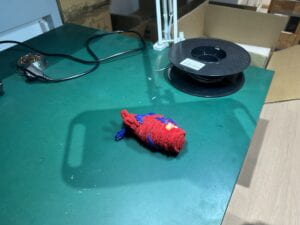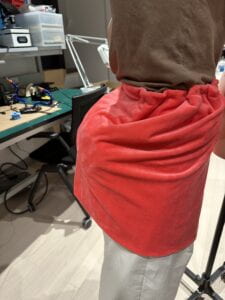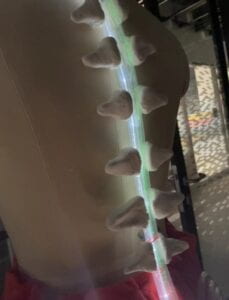Glowworm
In this project, we wanted to firefly-ize the human. We learned that glowworms flicker at night for courtship, much like a person would do with a wink. When the user presses the sensor in the ear,(we want this action to be done naturally when ruffling the hair, showing a flirtatious gesture, also for the purpose of courtship) the light on his/her body will be dimmed (including the spinal cord and buttocks) At the same time, in order to amplify the feature that fireflies flicker at the tail at night for courtship, we enlarged the buttocks part to make it more prominent. In addition, we also highlight the part of the spine because subconsciously, men will be whether the spine is in the right position as a criterion for courtship because it is a reflection of good fertility. (Dewan MC 2018) And the condition of the spine is shown in people’s walking position (Haber 2015)
The purpose of this work is to show the animalistic nature of human beings that is engraved in their genes, especially in the process of choosing a mate. We do not want to express the criticism of the almost primitive charm and natural selection in the process of choosing a spouse (according to Dawkins, our genes would lead us to select a mate who will produce the most offspring) , but we want to arouse people’s deeper reflection on love or human characteristics: what makes people tick, and what do people think about besides animal nature?
For the design, we used warm wool to knit in the head as well as the heart part. We hope to show the soft and sweet atmosphere of love directly through the choice of color and material.


And for the luminous spinal cord and buttocks, we used fiber optics. In fact, we had previously considered that fiber optics would not be so bright, but it would match the shimmering light of fireflies and the ambiguous atmosphere when flirting. But we did not anticipate that the fiber optic will be so dark and difficult to use led to control, perhaps in the future we will choose to replace the light strip or find a brighter light to provide light.

We also used the strip as a light source during the experiment, but the contact of the circuit was not good, and when we installed it on the clothes it was not under our control again. At the same time, the color of the strip would change every time we pressed it, and we did not find the reason for this situation. So we use the LEDs at last.
For the ass part of the water pipe shape design we have also done consideration. We envisioned a variety of knitting methods and finally decided to wrap and stack in a spiral fashion as seen in the video, so as to enlarge the hip part as much as possible, similar to the principle of a cone corset. In addition, We sewed padding on the hips to make them exaggerated and full.

As an improvement we will later abandon the design of the lower half of the skirt, using water pipe weave for garment production, or use transparent material bottoming because the current fabric looks and overall design has some cut. At the same time, in order to echo the head of the wool, in the lower half of the water pipe appropriate winding wool will be better.

Now we are using paper clay to make the spine part of the bone, after that we need to consider the movable design in this part
Code of the LEDs
int LEDPin1 = 9; //0 if you are using ATtiny int LEDPin2 = 6; //0 if you are using ATtiny int sensorPin = A2; // Analog pin 3 if you are using ATtiny int sensorValue1 = 0; int sensorValue2 = 0; int brightness1; int brightness2; void setup() { pinMode(LEDPin1, OUTPUT); pinMode(LEDPin2, OUTPUT); Serial.begin(9600); //Serial Comm doesn't work with ATtiny } void loop(){ sensorValue1 = analogRead(sensorPin); if (sensorValue1<200){ sensorValue1= 0; }else{ sensorValue1 = sensorValue1; } brightness1 = map(sensorValue1, 200, 1023, 0 ,255); Serial.print(brightness1); analogWrite(LEDPin1, brightness1); sensorValue2 = analogRead(sensorPin); if (sensorValue2<200){ sensorValue2=0; }else{ sensorValue2 = sensorValue2; } brightness2 = map(sensorValue2, 200, 1023, 0 ,255); Serial.print(brightness2); analogWrite(LEDPin2, brightness2); }
References
Dawkins, R. (2006). The Selfish Gene. Oxford University Press.
Dewan MC, Mummareddy N, Bonfield C. The influence of pregnancy on women with adolescent idiopathic scoliosis. Eur Spine J. 2018 Feb;27(2):253-263. doi: 10.1007/s00586-017-5203-7. Epub 2017 Jun 29. PMID: 28664223.
Haber, C.K., Sacco, M. Scoliosis: lower limb asymmetries during the gait cycle. Arch Physiother 5, 4 (2015). https://doi.org/10.1186/s40945-015-0001-1.